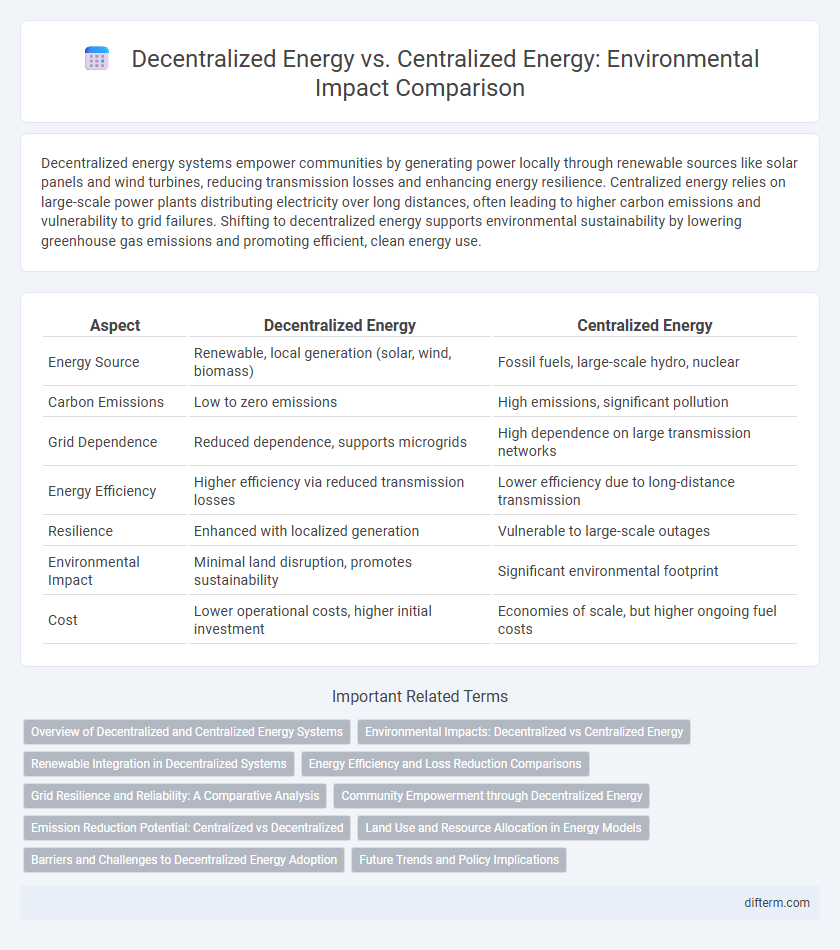Decentralized energy systems empower communities by generating power locally through renewable sources like solar panels and wind turbines, reducing transmission losses and enhancing energy resilience. Centralized energy relies on large-scale power plants distributing electricity over long distances, often leading to higher carbon emissions and vulnerability to grid failures. Shifting to decentralized energy supports environmental sustainability by lowering greenhouse gas emissions and promoting efficient, clean energy use.
Table of Comparison
| Aspect | Decentralized Energy | Centralized Energy |
|---|---|---|
| Energy Source | Renewable, local generation (solar, wind, biomass) | Fossil fuels, large-scale hydro, nuclear |
| Carbon Emissions | Low to zero emissions | High emissions, significant pollution |
| Grid Dependence | Reduced dependence, supports microgrids | High dependence on large transmission networks |
| Energy Efficiency | Higher efficiency via reduced transmission losses | Lower efficiency due to long-distance transmission |
| Resilience | Enhanced with localized generation | Vulnerable to large-scale outages |
| Environmental Impact | Minimal land disruption, promotes sustainability | Significant environmental footprint |
| Cost | Lower operational costs, higher initial investment | Economies of scale, but higher ongoing fuel costs |
Overview of Decentralized and Centralized Energy Systems
Decentralized energy systems generate power locally through renewable sources like solar panels and wind turbines, reducing transmission losses and enhancing grid resilience. Centralized energy systems rely on large-scale power plants, such as coal, natural gas, or nuclear facilities, delivering electricity via extensive transmission networks. Decentralized models promote energy independence and flexibility, while centralized systems benefit from economies of scale and centralized management.
Environmental Impacts: Decentralized vs Centralized Energy
Decentralized energy systems reduce transmission losses and lower greenhouse gas emissions by generating power closer to consumption points, enhancing energy efficiency. Centralized energy production often relies on fossil fuels and large-scale infrastructure, leading to higher environmental degradation and increased carbon footprint. Implementing decentralized renewable sources like solar and wind supports sustainable energy practices and mitigates air and water pollution.
Renewable Integration in Decentralized Systems
Decentralized energy systems enhance renewable integration by enabling localized generation from solar panels, wind turbines, and bioenergy, reducing transmission losses and increasing grid resilience. These systems facilitate real-time energy management through smart grids and energy storage technologies, optimizing the use of intermittent renewable resources. By distributing energy production closer to consumption points, decentralized models support higher penetration of renewables and mitigate the challenges faced by centralized energy grids.
Energy Efficiency and Loss Reduction Comparisons
Decentralized energy systems enhance energy efficiency by minimizing transmission losses, as power is generated closer to the point of consumption. Centralized energy often experiences significant energy loss during long-distance transmission and distribution, reducing overall system efficiency. Implementing decentralized solutions can reduce energy waste by up to 10-15%, improving sustainability and cost-effectiveness in power delivery.
Grid Resilience and Reliability: A Comparative Analysis
Decentralized energy systems enhance grid resilience by distributing power generation across multiple localized sources, reducing the risk of widespread outages caused by single-point failures common in centralized grids. This distributed architecture allows for faster recovery and adaptability to disruptions such as natural disasters or cyberattacks, improving overall reliability. Centralized energy models often depend on large-scale plants and extensive transmission networks, which can become vulnerable bottlenecks, while decentralized grids offer modular scalability and redundancy that strengthen energy security.
Community Empowerment through Decentralized Energy
Decentralized energy systems empower communities by enabling local generation and management of renewable resources such as solar panels and wind turbines, reducing dependence on centralized grids. This localized approach enhances energy resilience, lowers transmission losses, and promotes sustainable economic development within the community. By fostering energy autonomy, decentralized energy models support environmental stewardship and social equity, driving a transition toward cleaner, more inclusive energy systems.
Emission Reduction Potential: Centralized vs Decentralized
Decentralized energy systems offer significant emission reduction potential by enabling localized renewable energy generation, thereby reducing dependency on fossil fuel-based centralized power plants. Centralized energy production typically involves large-scale combustion of coal, oil, or natural gas, leading to higher greenhouse gas emissions and transmission losses. By integrating solar panels, wind turbines, and energy storage at the community level, decentralized energy reduces carbon footprints and enhances grid resilience.
Land Use and Resource Allocation in Energy Models
Decentralized energy systems optimize land use by integrating renewable sources like solar panels and wind turbines directly within local communities, reducing the need for extensive transmission infrastructure. Centralized energy models require large, dedicated sites for power plants and substations, often causing significant land disturbance and resource consumption. Efficient resource allocation in decentralized models enhances sustainability by minimizing energy losses and promoting adaptive grid management tailored to localized demand patterns.
Barriers and Challenges to Decentralized Energy Adoption
Decentralized energy adoption faces significant barriers such as high initial capital costs, lack of supportive regulatory frameworks, and limited grid integration capabilities. Technical challenges include maintaining energy reliability and managing distributed energy resources effectively within existing infrastructure. Additionally, consumer awareness and acceptance remain low, hindering widespread deployment of decentralized renewable energy systems.
Future Trends and Policy Implications
Decentralized energy systems, driven by advancements in renewable technologies and smart grids, are poised to dominate future energy landscapes by enhancing grid resilience and reducing transmission losses. Policy frameworks increasingly support decentralized models through incentives for local energy generation, storage solutions, and community-based microgrids, fostering energy democratization and sustainability. Regulatory shifts aim to integrate decentralized assets into national grids, promoting flexibility and decarbonization aligned with global climate targets.
decentralized energy vs centralized energy Infographic

 difterm.com
difterm.com